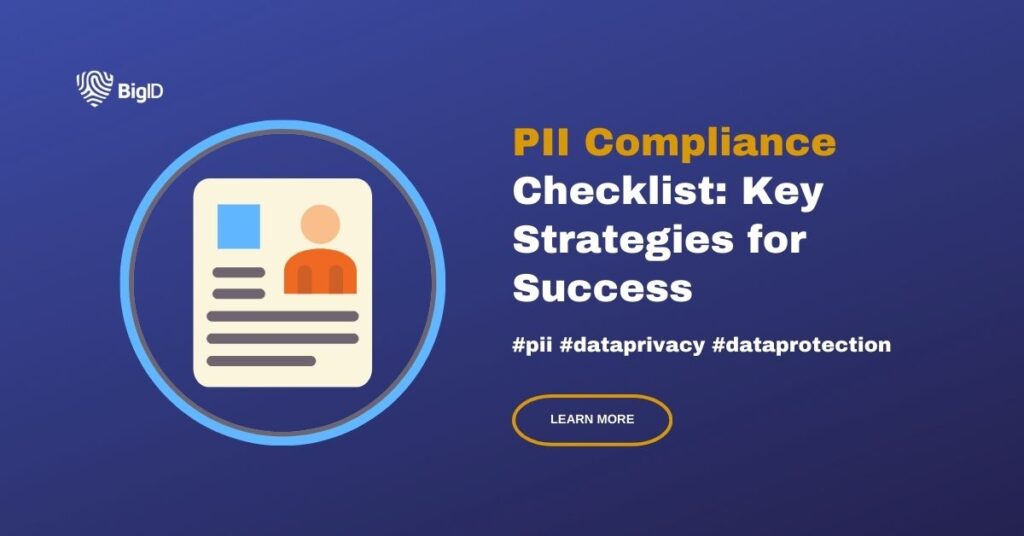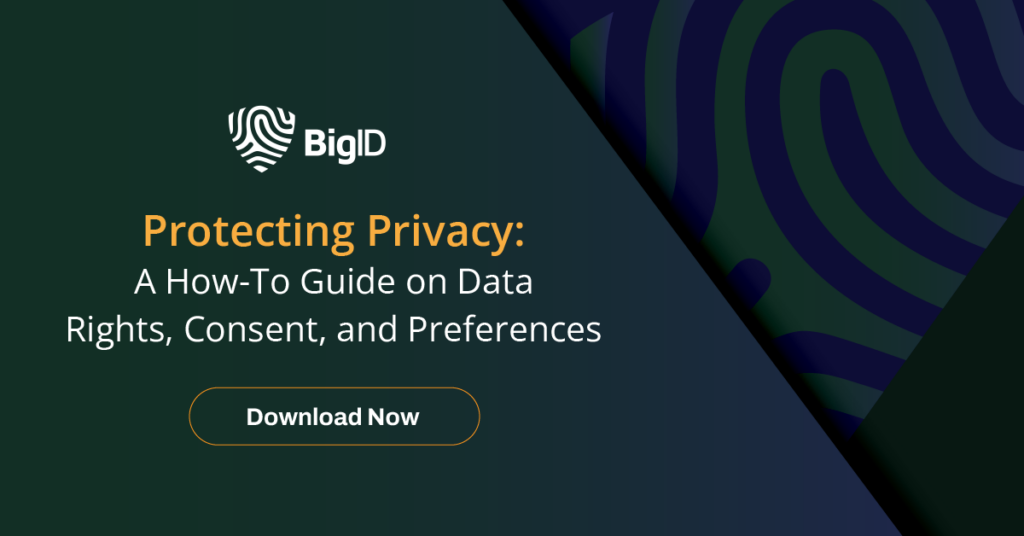With every new technology the world embraces, more data is created than ever before— but sometimes, less is more. Personal information is invaluable to businesses and individuals alike, but protecting Personal Identifiable Information (PII) should always be the number one priority. Read on to learn what PII compliance is, why it’s essential, who needs to comply, the specifications of the regulations, and how companies can implement a compliant plan.
Understanding PII Compliance
What is PII Compliance?
Understanding what constitutes PII is the first step towards effective compliance. Personally Identifiable Information (PII) refers to any data that can be used to identify a specific individual. The definition of PII may vary slightly depending on the jurisdiction and specific laws or regulations being referenced. However, the core principle remains the same: PII is information that can be used to distinguish or trace an individual’s identity.
This includes, but is not limited to:
- Name
- Social Security number
- Date and place of birth
- Mother’s maiden name
- Biometric records
- Home address
- Email address
- Phone number
- Driver’s license number
- Passport number
- Financial information (e.g., bank account numbers, credit card numbers)
Why is PII Compliance Important?
PII compliance is crucial for organizations to uphold the privacy rights of individuals, maintain trust with customers, and adhere to legal requirements. Failure to comply with PII regulations can result in severe financial penalties, damage to reputation, and loss of customer confidence.
Key Privacy Laws and Regulations for Protecting PII
General Data Protection Regulation (GDPR)
The General Data Protection Regulation (GDPR) is a comprehensive privacy law enacted by the European Union (EU) in 2018. It applies to organizations that process the personal data of EU residents, regardless of where the organization is located. GDPR sets strict guidelines for the collection, processing, storage, and protection of personal data, aiming to give individuals greater control over their personal information. Some key provisions of GDPR include:
- Consent: Organizations must obtain explicit consent from individuals before collecting or processing their personal data.
- Data Minimization: Data collection must be limited to what is necessary for the intended purpose, and data must be kept accurate and up to date.
- Right to Access and Data Portability: Individuals have the right to access their personal data held by organizations and request its transfer to another service provider.
- Data Security and Breach Notification: Organizations are required to implement appropriate security measures to protect personal data and notify authorities and affected individuals in the event of a data breach.
Non-compliance with GDPR can result in severe fines of up to €20 million or 4% of global annual turnover, whichever is higher.
Health Insurance Portability and Accountability Act (HIPAA)
HIPAA is a US federal law enacted in 1996 to protect the privacy and security of protected health information (PHI). HIPAA applies to healthcare providers, health plans, and healthcare clearinghouses, as well as their business associates who handle PHI. Key provisions of HIPAA include:
- Privacy Rule: The HIPAA Privacy Rule establishes national standards for the protection of PHI, including rules for its use and disclosure.
- Security Rule: The HIPAA Security Rule sets standards for safeguarding electronic PHI (ePHI) and requires covered entities to implement administrative, physical, and technical safeguards.
- Breach Notification Rule: Covered entities must notify affected individuals, the Department of Health and Human Services (HHS), and, in some cases, the media in the event of a breach of unsecured PHI.
HIPAA violations can result in civil and criminal penalties, with fines ranging from $100 to $50,000 per violation, depending on the level of negligence.
California Consumer Privacy Act (CCPA)
The California Consumer Privacy Act (CCPA) is a state-level privacy law that went into effect on January 1, 2020. CCPA grants California residents specific rights regarding their personal information and imposes obligations on businesses that collect or process such data. Key provisions of CCPA include:
- Right to Know: Individuals have the right to know what personal information is collected about them, how it is used, and whether it is sold or disclosed to third parties.
- Right to Opt-Out: Individuals have the right to opt-out of the sale of their personal information to third parties.
- Right to Deletion: Individuals can request the deletion of their personal information held by businesses.
- Non-Discrimination: Businesses are prohibited from discriminating against individuals who exercise their CCPA rights.
CCPA violations can result in fines of up to $7,500 per intentional violation and $2,500 per unintentional violation.
Personal Information Protection and Electronic Documents Act (PIPEDA)
PIPEDA is Canada’s federal privacy law governing the collection, use, and disclosure of personal information by private sector organizations. PIPEDA applies to commercial activities within provinces that do not have their own substantially similar privacy legislation, as well as cross-border data transfers. Key provisions of PIPEDA include:
- Consent: Organizations must obtain meaningful consent from individuals for the collection, use, and disclosure of their personal information.
- Accountability: Organizations are responsible for protecting personal information under their control and must designate an individual accountable for compliance.
- Access and Correction: Individuals have the right to access their personal information held by organizations and request corrections if it is inaccurate or incomplete.
- Safeguards: Organizations must implement appropriate security safeguards to protect personal information against loss, theft, and unauthorized access.
PIPEDA violations can result in fines of up to $100,000 for individuals and $500,000 for organizations. Additionally, organizations may face reputational damage and loss of customer trust for non-compliance.
Understanding and adhering to these key privacy laws and regulations is essential for organizations to ensure PII compliance and protect the privacy rights of individuals. Failure to comply with these laws can result in severe financial penalties, legal liabilities, and reputational damage. By implementing robust privacy practices and staying informed about evolving regulatory requirements, organizations can navigate the complex landscape of data privacy with confidence.
Principles of Protecting Personally Identifiable Information (PII)
Protecting personally identifiable information (PII) involves several important rules to keep people’s private information safe. Here’s a simplified explanation:
- Limit Collection: Only gather the PII that’s absolutely necessary for what you’re doing. Don’t gather more than you need.
- Secure Storage: Keep PII in safe places, like encrypted databases or locked filing cabinets, so unauthorized people can’t get to it.
- Restrict Access: Only allow people who really need to see the PII to access it. This helps prevent misuse.
- Proper Disposal: When you no longer need PII, get rid of it properly. Shred papers or securely delete digital files so they can’t be recovered.
- Inform Individuals: Let people know how you’re using their PII and who you might share it with. Be transparent about your practices.
- Consent: Get permission from individuals before collecting or sharing their PII. Respect their choices.
- Train Employees: Make sure everyone who works with PII understands the rules and knows how to keep it safe.
Common Challenges Faced When Securing PII
Challenges in protecting PII arise due to various factors:
- Technology: With the increasing use of digital systems and data storage, there’s a higher risk of data breaches and hacking.
- Volume of Data: Companies and organizations often handle large amounts of PII, making it difficult to manage and secure all of it effectively.
- Third-party Services: Many businesses rely on third-party services for various operations, which can increase the risk of data exposure if those services don’t handle PII properly.
- Human Error: Mistakes happen, and sometimes people accidentally mishandle PII, such as sending sensitive information to the wrong person or leaving it exposed.
- Legal Compliance: Keeping up with ever-changing privacy laws and regulations can be challenging, especially for organizations operating in multiple jurisdictions.
- Social Engineering: Cybercriminals often use tactics like phishing to trick people into revealing their PII, bypassing technical security measures.
PII Compliance Checklist
Achieving compliance with PII regulations involves implementing various measures to protect this sensitive data and ensure that it is collected, processed, stored, and transmitted in accordance with applicable laws and regulations. Some steps organizations can take to seamlessly achieve compliance are:
- Understand Applicable Laws and Regulations: Organizations need to familiarize themselves with relevant privacy laws and regulations such as the General Data Protection Regulation (GDPR) in the European Union, the Health Insurance Portability and Accountability Act (HIPAA) in the United States, or the Personal Information Protection and Electronic Documents Act (PIPEDA) in Canada. Understanding the requirements and guidelines provided by these laws is crucial for compliance.
- Implement Robust Security Measures: Organizations should implement strong security measures to safeguard PII from unauthorized access, disclosure, alteration, and destruction. This may include encryption, access controls, firewalls, intrusion detection systems, and regular security audits.
- Adopt Privacy by Design Principles: Privacy by Design is an approach that emphasizes integrating privacy and data protection considerations into the design and development of systems, processes, and products from the outset. By incorporating privacy principles into their operations, organizations can minimize the risk of non-compliance and data breaches.
- Establish Data Governance Frameworks: Implementing effective data governance frameworks helps organizations manage PII throughout its lifecycle, from collection to disposal. This includes defining roles and responsibilities, establishing data retention policies, conducting privacy impact assessments, and ensuring accountability for compliance.
- Provide Employee Training and Awareness: Employees play a crucial role in protecting PII, so organizations should provide comprehensive training on data protection best practices, privacy policies, and procedures. Increasing employee awareness about the importance of safeguarding PII can help prevent human errors and security breaches.
- Monitor and Audit Compliance: Regular monitoring and auditing of data processing activities are essential to ensure ongoing compliance with privacy regulations. This involves conducting internal assessments, audits, and reviews to identify potential risks, gaps, and areas for improvement.
- Maintain Transparent Privacy Practices: Organizations should maintain transparent privacy practices by providing clear and easily accessible privacy notices to individuals regarding how their PII is collected, used, and shared. Transparency builds trust and helps organizations demonstrate accountability for their data processing activities.
Implementing a PII Policy
A PII policy, also known as a Personally Identifiable Information (PII) compliance policy, should encompass various aspects related to the handling, protection, and management of personal information. Here’s what a comprehensive PII policy should entail:
- Purpose and Scope: Clearly define the purpose of the policy, which is to establish guidelines and procedures for the protection of personally identifiable information. Specify the scope of the policy, including the types of PII covered and the individuals or entities to which it applies.
- Legal and Regulatory Compliance: Outline relevant laws, regulations, and industry standards that govern the collection, processing, storage, and transmission of PII. Ensure that the policy aligns with applicable legal requirements, such as the GDPR, HIPAA, CCPA, and PIPEDA, as well as any other relevant data protection laws.
- Definitions: Provide definitions for key terms and concepts related to PII, such as personal information, sensitive information, data subject, data controller, data processor, consent, and data breach. Clarify any terminology specific to your organization or industry.
- Data Collection and Use: Detail procedures for collecting and using PII, including obtaining consent from individuals when required, specifying lawful purposes for data collection, limiting data collection to what is necessary, and ensuring transparency about how PII will be used.
- Data Security and Protection: Establish measures to ensure the security and protection of PII throughout its lifecycle. This may include implementing encryption, access controls, authentication mechanisms, secure data storage, data masking, and regular security assessments to identify and address vulnerabilities.
- Data Retention and Disposal: Define policies and procedures for the retention and disposal of PII in accordance with legal requirements and business needs. Specify retention periods for different types of PII and outline secure methods for data disposal, such as shredding physical documents or securely deleting digital files.
- Data Access and Sharing: Specify who within the organization has access to PII and under what circumstances access is granted. Define procedures for sharing PII with third parties, including data processors and service providers, and ensure that appropriate contractual safeguards are in place to protect PII when shared externally.
- Individual Rights: Inform individuals about their rights regarding their PII, such as the right to access, rectify, restrict processing, and delete their data. Outline procedures for individuals to exercise these rights and ensure that requests are handled promptly and transparently.
- Training and Awareness: Require regular training and awareness programs for employees who handle PII to ensure they understand their responsibilities and the importance of compliance. Provide guidance on recognizing and responding to potential data security incidents or breaches.
- Monitoring and Enforcement: Establish mechanisms for monitoring compliance with the PII policy, such as conducting audits, reviewing access logs, and investigating any suspected violations. Define consequences for non-compliance and disciplinary measures for employees who fail to adhere to the policy.
- Policy Review and Updates: Commit to regularly reviewing and updating the PII policy to reflect changes in legal requirements, technological advancements, organizational practices, and emerging risks. Ensure that employees are notified of policy updates and receive appropriate training on any changes.
- Reporting and Incident Response: Outline procedures for reporting and responding to data breaches or security incidents involving PII. Define roles and responsibilities for incident response team members, establish communication channels for reporting incidents, and specify requirements for notifying affected individuals, regulatory authorities, and other stakeholders.
The Role of Artificial Intelligence in PII Compliance
Leveraging AI for Data Protection and Compliance
Artificial intelligence (AI) technologies can play a significant role in enhancing PII compliance efforts. AI-powered solutions can automate compliance monitoring, detect anomalous behavior indicative of potential breaches, and provide insights into data protection risks.
Advanced Threat Detection
AI algorithms can analyze large volumes of data to identify patterns and anomalies indicative of potential security threats. By leveraging machine learning and predictive analytics, organizations can detect and respond to threats in real-time, minimizing the risk of PII breaches.
Anomaly Detection
AI-based anomaly detection systems can identify unusual patterns or deviations from normal behavior within datasets. This can help organizations detect insider threats, unauthorized access attempts, or abnormal data usage that may indicate a potential breach of PII.
Behavioral Analysis
AI-driven behavioral analysis tools can analyze user behavior patterns to identify suspicious activities or deviations from typical usage patterns. By monitoring user interactions with data and systems, organizations can detect and mitigate potential security risks before they escalate.
Automated Compliance Monitoring
AI technologies can automate the monitoring of compliance with privacy regulations by analyzing data processing activities, identifying potential violations, and generating alerts or reports for remediation. This streamlines compliance efforts and helps organizations stay ahead of regulatory requirements.
Ethical Considerations and Bias Mitigation in AI Algorithms
It’s essential for organizations to consider ethical implications and mitigate bias when deploying AI algorithms for PII compliance. Ensuring transparency, fairness, and accountability in AI systems helps build trust and ensures that compliance efforts align with ethical standards.
BigID’s Approach to Safeguarding PII
Every time a business collects an address, social security number, credit card, or any other personally identifiable information they have a responsibility to protect that information at the highest level. BigID is the industry leading platform for data privacy, security, compliance and AI data management empowering organizations of all sizes to get more visibility and value from their data.
With BigID you can:
- Discover all your data — everywhere: Find and inventory your sensitive, critical, and high-risk data for a clear view of all the data you store and maintain.
- Automate advanced, ML-based classification: Automatically classify, tag, and inventory all PII and high-risk data in accordance with regulations like CCPA, CPRA and the APRA.
- Reduce your data risk profile: Minimize duplicate, similar, and redundant data— fix data quality issues and automate workflows based on retention timelines.
- Know your privacy risk — and reduce it: Prioritize your most high-risk, sensitive data like PII. Identify and minimize risk on sensitive data with Privacy Impact Assessments(PIA) that incorporate data parameters like data type, location, residency, and more.
To see how BigID can help your organization better protect sensitive data like PII and achieve compliance with evolving regulations— get a 1:1 demo with our privacy experts.



